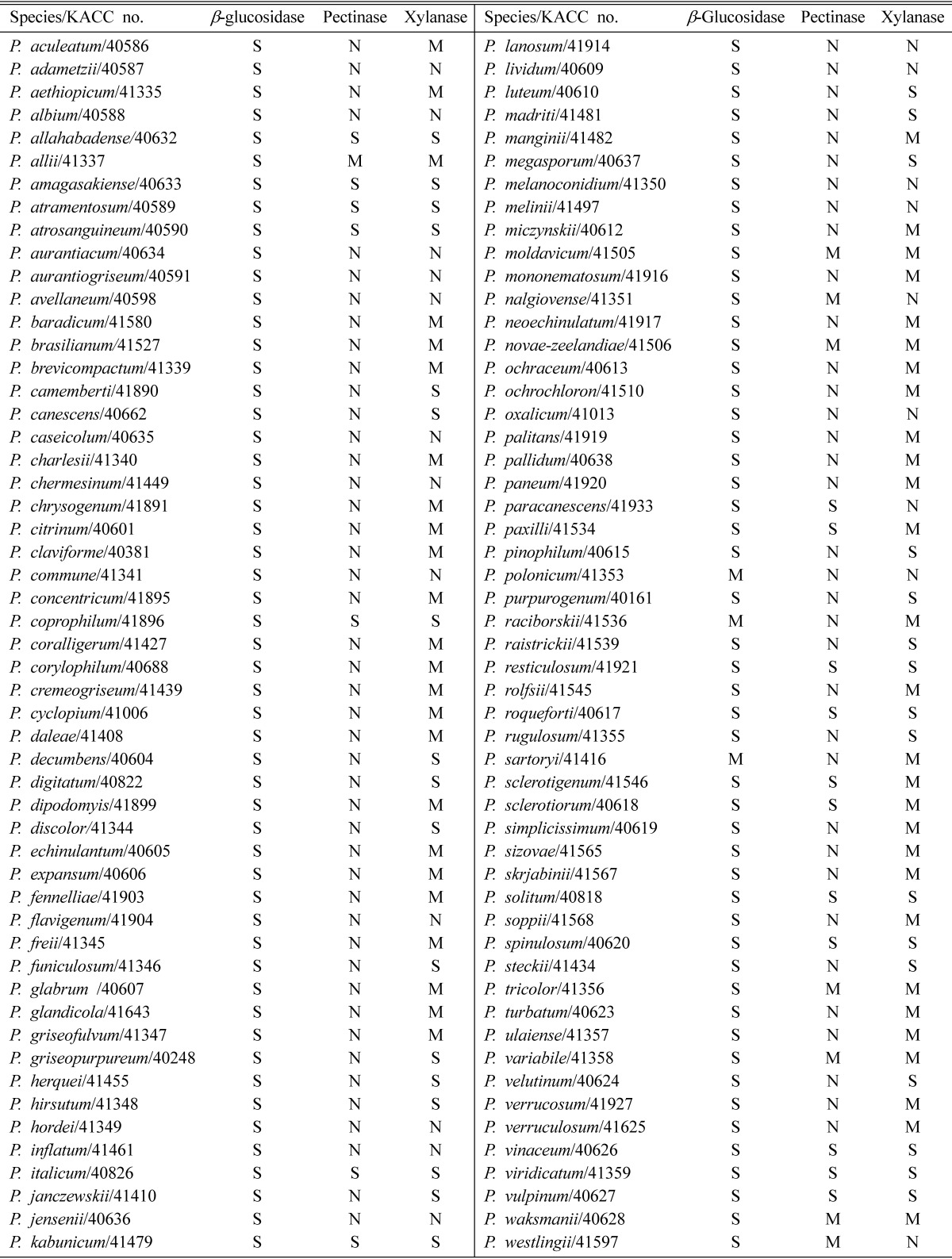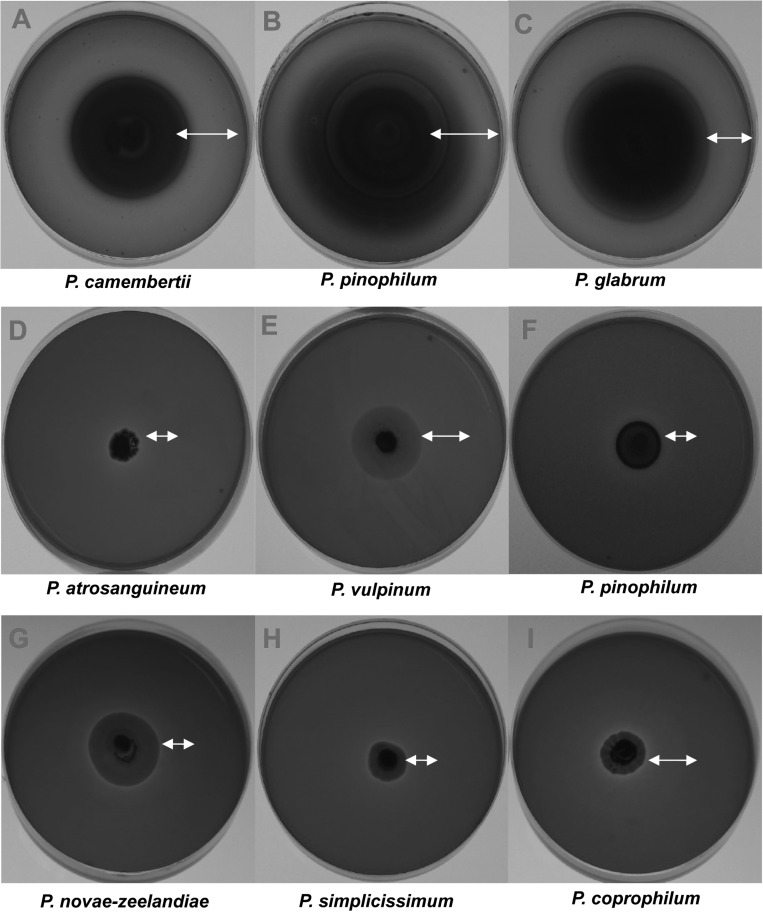Abstract
A total of 106 Penicillium species were tested to examine their ability of degrading cellobiose, pectin and xylan. The activity of β-glucosidase was generally strong in all the Penicillium species tested. P. citrinum, P. charlesii, P. manginii and P. aurantiacum showed the higher ability of producing β-glucosidase than other tested species. Pectinase activity was detected in 24 Penicillium species. P. paracanescens, P. sizovae, P. sartoryi, P. chrysogenum, and P. claviforme showed strong pectinase activity. In xylanase assay, 84 Penicillium species showed activity. Strong xylanase activity was detected from P. megasporum, P. sartoryi, P. chrysogenum, P. glandicola, P. discolor, and P. coprophilum. Overall, most of the Penicillium species tested showed strong β-glucosidase activity. The degree of pectinase and xylanase activity varied depending on Penicillium species.
Keywords: Chromogenic media, β-Glucosidase, Pectinase, Penicillium, Xylanase
Penicillium is well-known fungus that served as original source of the first antibiotic Penicillin. The species belonging to Penicillium are generally called as green moulds due to their color of spores and mycelium. This fungus recognized generally by its dense brush-like spore-bearing structures is a taxonomically large and difficult genus encountered almost everywhere, and usually the most abundant genus of fungi in soils and one of major groups of indoor moulds (Domsch, 1980; Pitt et al., 1979). The common occurrence of Penicillium species in food is a particular problem because some species produce toxins and may render food inedible or even dangerous (de Hoog et al., 2000; Pitt et al., 2000). On the other hand, some species of Penicillium are beneficial to humans. Cheeses are ripened with species of Penicillium and are quite safe to eat.
Penicillium also has been known as producers of useful enzymes that degrade proteins, xylan, starch, lipids etc. from agricultural wastes (Techapun et al., 2003). However, in spite of its prevalence in nature, not many species of Penicillium have been known for their ability of producing extracellular enzymes. Recently, Krogh et al. (2004) tried to screen some Penicillium fungi for cellulase and xylanase production. To better use of this fungus in industry such as food, textile, and bioremediation, further search for the source of enzymes needs to be proceeded. In this context this study was aimed at evaluation of vast numbers of Penicillium species using chromogenic medium (Castro et al., 1995) that allowed us to examine the degree of β-glucosidase, pectinase and xylanase the activity.
Totally, 106 Penicillium species were provided by Korean Agricultural Culture Collection (KACC, Suwon, Korea) and used for the present study. Fungal cultures were maintained on potato dextrose agar (Difco, USA). For the test of extracellular enzyme activities, the cultures were grown on PDA and transferred to chromogenic media containing each carbon source as enzymatic substrates (Ten et al., 2004). Chromogenic media contained 0.1% yeast nitrogen base (Difco, USA), and 0.5% D-cellobiose (Sigma, USA), polygalacturonic acid (MP Biomedical, France), xylan from oat spelts (Sigma, USA) as enzymatic carbon source, 0.5% Congo Red dye (Sigma, USA) for chromogenic reaction (Teather and Wood, 1982), and 1.5% agar powder (Yoon et al., 2007). After 5 days of culturing at 25℃, evaluation of enzyme activity was conducted by measuring clear zone (plaque) peripherally formed around the fungal colony resulting from reaction between chromogenic substrates and the enzyme produced by the fungus. The degree of enzyme activity was expressed as strong (S), moderate (M), and weak or no activity (N) by measuring the size of clear zone. When the clear zone size was over 0.5 cm, the activity was treated as strong. Moderate activity was recorded when clear zone size was 0.1~0.4 cm. When clear zone size was less than 0.1 cm, the activity was treated as no activity. There was little difference between the sizes of clear zone measured by a ruler and shown on photo due to the resolution of photo image. The values measured by a ruler were used for comparative determination of clear zone size. All the measurement values were obtained from 5 replicate plates of each species.
Table 1 shows the results of the detection of three extracellular enzymes in 106 species of Penicillium. D-cellobiose was degraded more easily than other substrates because all the species in Table 1 showed activity. One hundred and three of 106 species showed strong β-glucosidase activity. Thus, the activity of β-glucosidase is generally strong in most of the Penicillium species tested (Table 1, Fig. 1). Examples of β-glucosidase activity formed on chromogenic media are shown in Figs. 1A-C. The breaking activity of pectin was observed from 24 of 106 species. Among these 24 pectinase positive species, 18 species showed strong activity. Especially, P. coprophilum, P. sartoryi, P. sizovae, P. pinophilum and P. paracanescens showed stronger pectinase activity than others. This indicates not many Penicillium species can degrade pectin compounds strongly. Examples of pectinase activity on chromogenic media are given in Figs. 1D-F. Compared to the number of Penicillum species that could degrade pectin, more number of Penicillium species showed the ability of xylan degradation. Twenty three species showed strong xylanse activity and fifty one species showed moderate activity. In xylanase assay, 84 Penicillium species showed the activity. In these xylanase positive species, 33 species showed strong activity and 51 species displayed moderate activity. Strongest xylanase activity was detected from P. coprophilum, P. simplicissimum, P. sartoryi and, P. discolor. Figs. 1G-H show the examples of xylanse activity checked on chromogenic media. It seems that Penicillium is good sources of finding noble fungal xylanase.
Table 1.
Detection of extracellular enzyme activities in Penicillium spp. on chromogenic medium

S = strong enzyme activity, M = moderate enzyme activity, and N = weak or no enzyme activity.
Fig. 1.
Examples of observation of different enzyme activities produced by diverse Penicillium species on chromogenic media. A, B, C : β-glucosidase. D, E, F : pectinase. G, H, I : xylanase. Arrows indicate clear zone.
Among the 106 species tested, P. allahabadense, P. atrosanguineum, P. coprophilum, P. italicum, P. kabunicum, P. resticulosum, P. roqueforti, P. solitum, P. spinulosum, P. viridicatum, P. vulpinum, and P. waksmanii showed strong activities of all the three extracellular enzymes tested (Table 1). Since there has been not much information in literature on the activity of β-glucosidase, pectinase, and xylanse in these 12 species, the results of Table 1 are quite useful for the understanding of their biochemical properties and nutrient physiology.
In conclusion, our work generated basic information on the vast numbers of Penicillium species. The genus contained many species that can be used for production of extracellular β-glucosidase, pectinase, and xylanse. Since all the species tested in this study is available from KACC, our results will be useful to the researchers who are searching for the tested enzyme sources. The genome sequence project on the human pathogen Penicillium marneffei (de Hoog et al., 2000) has been performed and it is currently in assembly stage. Thus, its genome information will be available soon at genome project database in GenBank database (http://www.ncbi.nlm.nih.gov/). The genomic information of P. marneffei surely provides useful background information and opportunity for the search of genes encoding extracellular enzymes from Penicillium spp. used in this study.
Acknowledgment
This study was supported by a grant (project no : 20060401034815) of BioGreen21 program from the Rural Development of Administration in Korea.
References
- 1.Castro GR, Baigori MD, Sineriz F. A plate technique for screening of inulin degrading microorganisms. J Microbiol Methods. 1995;22:51–56. [Google Scholar]
- 2.de Hoog GS, Guarro J, Gene J, Figueras MJ. Atlas of Clinical Fungi. 2nd ed. Vol. 1. Utrecht, The Netherlands: Centraalbureau voor Schimmelcultures; 2000. [Google Scholar]
- 3.Domsch KH, Gams W, Anderson TH. Compendium of soil fungi. Vol. 2. London: Academic Press; 1980. [Google Scholar]
- 4.Krogh KBR, Morkeberg A, Friscad JC, Olsson L. Screening genus Penicillium for producers of cellulolytic and xylanolytic enzymes. Appl Biochem Biotechnol. 2004;113:389–401. doi: 10.1385/abab:114:1-3:389. [DOI] [PubMed] [Google Scholar]
- 5.Pitt JI. The genus Penicillium and its teleomorphic states Eupeniciliium and Talaromyces. Landon: Academic press; 1979. [Google Scholar]
- 6.Pitt JI, Basilico JC, Abarca ML, Lopez C. Mycotoxins and toxigenic fungi. Med Mycol. 2000;38:41–46. [PubMed] [Google Scholar]
- 7.Teather RM, Wood PJ. Use of congo red-polysaccharide interactions in enumeration and characterization of cellulolytic bacteria from bovine rumen. Appl Environ Microbiol. 1982;43:777–780. doi: 10.1128/aem.43.4.777-780.1982. [DOI] [PMC free article] [PubMed] [Google Scholar]
- 8.Techapun C, Poosaran N, Waanabe M, Sasaki K. Thermostable and alkaline-tolerant microbial cellulase-free xylanases produced from agricultural wastes and the properties required for use in pulp bleaching bioprocesses: a review. Process Biochem. 2003;38:1327–1340. [Google Scholar]
- 9.Ten LN, Im WT, Kim MK, Kang MS, Lee ST. Development of a plate technique for screening of polysaccharide-degrading microorganisms by using a mixture of insoluble chromogenic substrates. J Microbiol Methods. 2004;56:375–382. doi: 10.1016/j.mimet.2003.11.008. [DOI] [PubMed] [Google Scholar]
- 10.Yoon JH, Park JE, Suh DY, Hong SB, Ko SJ, Kim SH. Comparison of dyes for easy detection of extracellulase in fungi. Mycobiology. 2007;35:21–24. doi: 10.4489/MYCO.2007.35.1.021. [DOI] [PMC free article] [PubMed] [Google Scholar]



